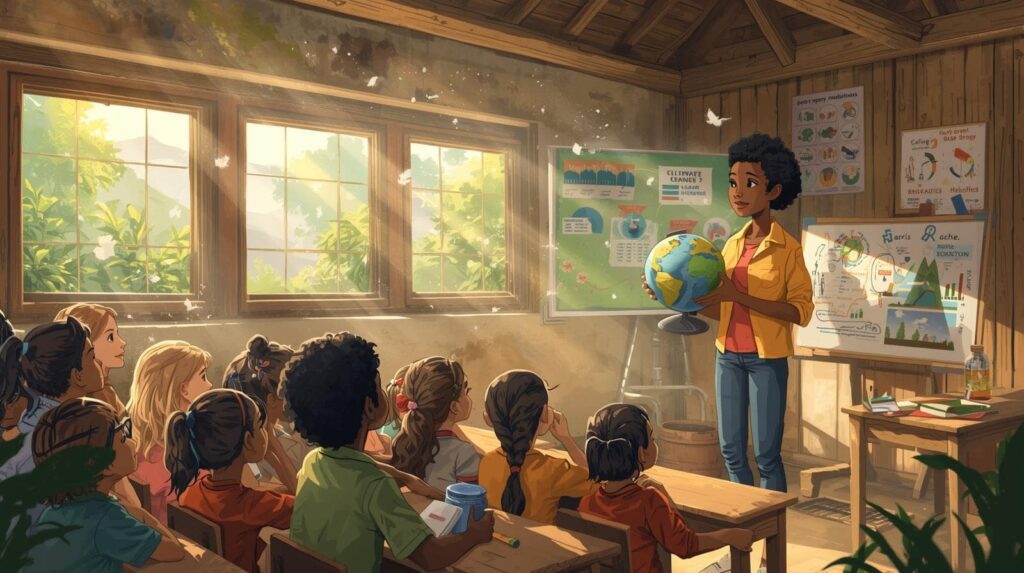
Bringing Climate Change Education to Rural Classrooms
By Sameer C, Co-Founder, Global Geographic Inc.
Climate change is no longer a distant global issue—it’s a local reality impacting every community, especially those in rural and underserved regions. Rising temperatures, unpredictable rainfall, crop failures, and resource scarcity are affecting livelihoods in ways that demand immediate awareness and action. Yet, despite these challenges, rural schools often lack access to climate education resources that could equip young minds with the knowledge to build sustainable futures.
At Global Geographic, we believe that empowering students in rural communities with environmental education is not just an academic initiative—it’s a long-term investment in resilience, innovation, and equity.
1. The Importance of Climate Literacy in Rural Areas
Rural communities are deeply connected to natural systems. Farmers, small entrepreneurs, and families depend on local water, soil, and forest resources for survival. However, without an understanding of climate dynamics, many are left vulnerable to its unpredictable impacts.
Climate literacy helps rural students grasp the “why” behind changing seasons, droughts, or floods. When young people understand how human actions affect ecosystems, they become more capable of leading local adaptation efforts—whether through water conservation, renewable energy adoption, or sustainable agriculture.
2. Challenges in Reaching Rural Schools
Despite the need, many rural schools in the U.S. and developing countries face barriers to implementing climate education.
- Limited access to quality materials – Many curricula still lack environmental content adapted to local conditions.
- Infrastructure gaps – Poor internet connectivity limits the use of interactive digital tools.
- Teacher training – Educators often lack the background to confidently teach complex environmental topics.
- Resource constraints – Rural schools struggle to afford updated teaching aids, labs, or field projects.
Overcoming these challenges requires partnerships, creative delivery methods, and community-driven solutions.
3. Integrating Climate Education into Existing Curriculum
At Global Geographic, we promote a “local lens” approach to climate education. This means integrating climate concepts into everyday subjects rather than treating them as separate lessons.
For example:
- In science, students explore renewable energy or soil health.
- In math, they analyze rainfall data or chart temperature changes.
- In geography, they study regional ecosystems and conservation strategies.
- In social studies, they debate environmental policies and local adaptation plans.
This interdisciplinary approach ensures that climate education feels relevant and practical, not theoretical.
4. Leveraging Technology for Remote and Hybrid Learning
Digital technology plays a critical role in bridging educational gaps. Even in areas with limited infrastructure, simple tools like mobile phones, tablets, and solar-powered learning stations can deliver powerful lessons.
At Global Geographic, we are exploring partnerships that provide:
- Offline digital modules on environmental science
- Localized video content in regional languages
- Interactive mapping tools to visualize local climate patterns
By combining traditional teaching with accessible tech, we can reach more learners and make education interactive and engaging.
5. Community Involvement: Learning Beyond the Classroom
Education is most effective when it extends beyond textbooks. Rural schools can engage families, farmers, and community leaders in climate awareness activities such as:
- Tree planting drives to combat deforestation
- Water conservation campaigns led by student clubs
- Local data collection projects, where students monitor rainfall, waste, or biodiversity
These initiatives build community ownership and turn students into change agents. When children lead, adults listen—and transformation follows.
6. Empowering Teachers as Climate Champions
Teachers are the backbone of any educational reform. Training them to deliver climate-related content with confidence and creativity is essential.
Global Geographic supports the idea of Teacher Empowerment Workshops focused on:
- Understanding local climate impacts
- Simplifying scientific concepts for young learners
- Designing classroom activities using low-cost materials
- Incorporating real-life problem-solving projects
When teachers feel empowered, they inspire entire classrooms to think critically and act responsibly.
7. Partnering for Sustainable Educational Impact
No single organization can tackle this alone. Collaboration among NGOs, local governments, and educational institutions is vital. Global Geographic works to build partnerships that bring together environmental scientists, educators, and policymakers to design scalable models for rural schools.
Joint programs can:
- Develop region-specific learning materials
- Sponsor eco-labs and digital classrooms
- Support teacher exchanges and mentorships
Such partnerships amplify impact and create a long-term framework for climate education in rural communities.
8. The Broader Goal: Building Climate-Resilient Generations
The ultimate aim of bringing climate education to rural classrooms is to nurture climate-resilient citizens—young people who understand the environment, respect its limits, and innovate for sustainability.
When students in rural America, Africa, or Asia learn how to measure rainfall or track soil moisture, they’re not just completing a project—they’re becoming part of a global movement for environmental awareness and adaptation.
Education doesn’t just inform—it transforms. And in the fight against climate change, transformation begins with understanding.
Conclusion
Climate change education in rural areas is about more than textbooks—it’s about giving every child the tools to shape their future and protect their environment. At Global Geographic, we’re committed to creating programs that bring environmental awareness into classrooms, empower educators, and engage communities in sustainable action.
Because when knowledge reaches the most remote corners, hope grows stronger. And with every informed student, the world moves one step closer to resilience.